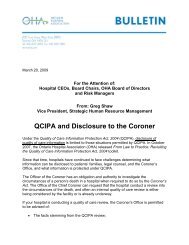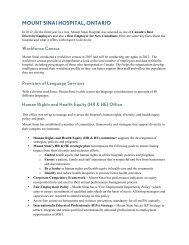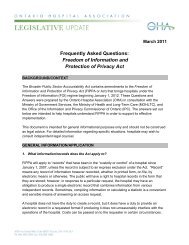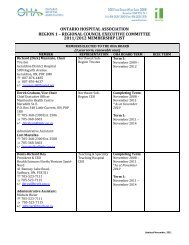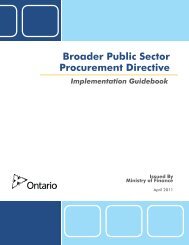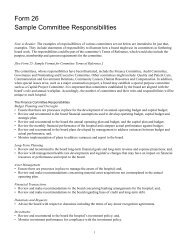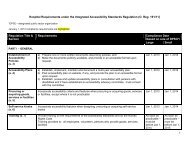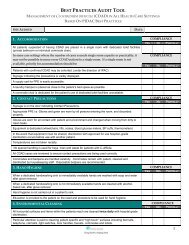Roles and Responsibilities of Physicians Supervising PAs - Ontario ...
Roles and Responsibilities of Physicians Supervising PAs - Ontario ...
Roles and Responsibilities of Physicians Supervising PAs - Ontario ...
- No tags were found...
You also want an ePaper? Increase the reach of your titles
YUMPU automatically turns print PDFs into web optimized ePapers that Google loves.
who receives care pursuant to the medical directive. It is important to remember that theaccountability <strong>and</strong> responsibility for the directive <strong>and</strong> for the delegation <strong>of</strong> any controlled acts itcontains remain with the signing physician.When developing the directive, consider each <strong>of</strong> the following issues <strong>and</strong> ensure that thisconsideration is reflected in the document:1. Assess the risk.a. What is the procedure, treatment or intervention being ordered?b. How predictable are the outcomes?c. Does safe management <strong>of</strong> the possible outcomes require physician involvement orintervention?d. Are the appropriate resources available to intervene as required?e. Will delegation <strong>of</strong> the controlled act (if any) increase the risk to patients?If the risk assessment results in the conclusion that patients’ best interests would not becompromised by a medical directive, the following considerations should be taken into account.2. Consider who should be involved in the development <strong>of</strong> a medical directive.Although the directive is, strictly speaking, a physician’s order, it has a significant impact on anumber <strong>of</strong> other health care pr<strong>of</strong>essionals who will be involved in the patient’s care. Accordingly,the development <strong>of</strong> medical directives should be undertaken with a collaborative team approach. All<strong>of</strong> the health care pr<strong>of</strong>essionals who may be affected by the medical directive should be involved inits development.3. Determine the qualifications, skills or knowledge required to carry out the directive.4. Ensure that the directive addresses the requirements <strong>of</strong> Consent to Medical Treatment. 13A medical directive cannot be implemented until the patient has provided informed consent (whichmay be in writing or verbal). In a medical directive, a physician proposes that a specific treatment(i.e., an x-ray) be performed for a range <strong>of</strong> patients who meet certain conditions. Instituting amedical directive raises the possibility that a physician may not be available to obtain the patient’sinformed consent to the proposed treatment. Under these circumstances, the physician is alsoassigning to another person the responsibility for obtaining the patient’s informed consent for theproposed treatment, intervention or procedure. Obtaining informed consent includes the provision<strong>of</strong> information <strong>and</strong> the ability to answer questions about the material risks <strong>and</strong> benefits <strong>of</strong> theprocedure, treatment or intervention proposed. If the individual who will be enacting the medicaldirective is unable to provide the information that a reasonable person would want to know in thecircumstances, the implementation <strong>of</strong> the medical directive is inappropriate.5. Consider who will sign the directive.The overriding principle <strong>of</strong> delegation is that it must occur in the context <strong>of</strong> a physician-patientrelationship. Accordingly, a physician who is ultimately responsible for the patient’s care must signthe medical directive. At least one <strong>of</strong> the signatories to the medical directive must be available (onsite or by phone) at the time it is implemented in case clarification or further intervention is required.In some hospitals medical directives are created <strong>and</strong> approved by Committees <strong>and</strong> signed only byChiefs <strong>of</strong> departments or divisions. In the College’s view this arrangement is unlikely to meet therequirement that the physician signing the medical directive must have a physician-patientUpdated July 2011 20





